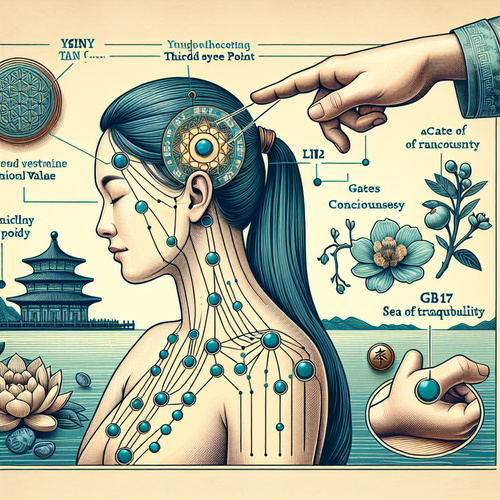
Feeling Tense? Here’s How Acupressure Can Change That.
Share
Stress and tension have become an unavoidable part of modern life. Whether it’s deadlines at work, family responsibilities, or the general whirlwind of daily activities, it’s easy to feel overwhelmed. While there are many ways to manage stress, acupressure is a centuries-old technique that can effectively help bring relief. Let’s dive deeper into how acupressure can ease tension and make you feel rejuvenated.
Acupressure is a traditional therapy that originates from Chinese medicine. It involves applying gentle pressure on specific points on the body to stimulate energy flow, known as “qi” (pronounced "chee"). When your energy flow is blocked, it can lead to stress, tension, and even physical discomfort. Acupressure helps release these blockages, promoting harmony in the body and mind.
How Does Acupressure Work?
Practitioners of acupressure believe that the body has a system of meridians or energy channels. Along these meridians are acupoints, which influence the flow of energy in the body. By applying pressure to these acupoints, you can stimulate circulation, relax muscles, and release endorphins — the body’s natural painkillers. This, in turn, helps reduce stress and tension.
Unlike acupuncture, which involves the use of fine needles, acupressure requires no tools. It’s gentle, safe, and something you can even learn to do on your own!
Acupressure Points to Relieve Tension
If you’ve been feeling tense lately, here are a few acupressure points you can try targeting to get some much-needed relief:
- Yintang (Third Eye Point): Located between your eyebrows, this point is excellent for relieving stress and calming the mind. Use your index finger to apply gentle pressure, and take slow, deep breaths as you do so.
- LI4 (Hegu/Union Valley): Found in the webbing between your thumb and index finger, this point is ideal for reducing tension headaches and promoting relaxation. Apply firm pressure using the thumb and index finger of your opposite hand.
- GB20 (Gates of Consciousness): These points are located underneath the base of your skull, in the hollow spaces where your neck muscles attach. Using your thumbs, apply steady pressure for a soothing release of neck and shoulder tension.
- CV17 (Sea of Tranquility): Situated in the center of your chest, this point is perfect for relieving emotional stress and restoring calmness. Apply gentle pressure with your fingers or palm while breathing deeply.
The Benefits of Acupressure for Stress Relief
One of the main reasons people turn to acupressure is its ability to reduce stress naturally. Here are some of the key benefits of using acupressure to manage tension:
- Promotes Relaxation: Acupressure helps activate the parasympathetic nervous system, which is responsible for calming the body. This can lead to an instant sensation of relaxation.
- Improves Sleep: By reducing stress levels and calming the mind, acupressure can help improve the quality of your sleep, leaving you feeling more refreshed.
- Reduces Muscle Tension: Targeting specific acupoints can release tightness in your muscles, especially in areas like the neck, shoulders, and back.
- Boosts Energy Levels: Acupressure promotes the smooth flow of energy in the body, eliminating fatigue and increasing vitality over time.
It’s worth noting that these benefits don’t just feel good temporarily — they can have lasting effects when acupressure is practiced consistently.
How to Get Started
The beauty of acupressure is that it’s simple to learn and can be done anywhere — at your desk, on the couch, or even during your morning commute (provided you’re not driving!). Follow these quick steps to get started with acupressure:
- Begin by finding a quiet, comfortable space where you can relax.
- Identify the acupressure point you’d like to work on. Use a diagram or guide if needed.
- Apply gentle, steady pressure to the point using your fingertips or thumb. Avoid pressing too hard; the goal is to feel relief, not pain!
- Hold the pressure for 30 seconds to a minute. Breathe deeply and slowly while focusing on releasing tension.
With consistency, you’ll become more familiar with the points that work best for your needs. Some people even incorporate acupressure into their daily routines to maintain balance and well-being.
When to Seek Professional Help
While self-acupressure is effective for mild stress and tension, it’s a good idea to consult a professional acupressure therapist for chronic symptoms or more targeted relief. They can guide you toward the best acupressure points for your body’s unique needs and combine their knowledge with techniques you may not be aware of.
If you’re unsure whether acupressure is right for you, don’t hesitate to consult a healthcare professional, especially if you have underlying medical conditions or experience severe physical pain.
In Conclusion
Acupressure offers a natural, accessible, and highly effective way to relieve tension and feel at ease. By stimulating specific points on your body, you can enhance your overall sense of well-being without the need for medication or extensive therapies. Whether you practice it solo or with the help of an expert, acupressure could be the key to a calmer and more balanced you.
The next time you find yourself feeling tense, take a few minutes to try acupressure. With consistent practice, you’ll likely notice a significant difference in how you manage stress — and best of all, it doesn’t cost a thing!
